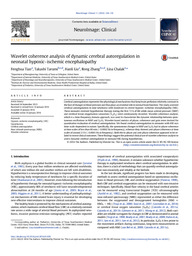| dc.contributor.author | Tian, Fenghua | |
| dc.contributor.author | Tarumi, Takashi | |
| dc.contributor.author | Liu, Hanli | |
| dc.contributor.author | Zhang, Rong | |
| dc.contributor.author | Chalak, Lina | |
| dc.date.accessioned | 2017-02-27T15:11:20Z | |
| dc.date.available | 2017-02-27T15:11:20Z | |
| dc.date.issued | 2016-01-25 | |
| dc.identifier.citation | Published in NeuroImage: Clinical 11: 124-132, 2016 | en_US |
| dc.identifier.issn | 2213-1582 | |
| dc.identifier.uri | http://hdl.handle.net/10106/26479 | |
| dc.description.abstract | Cerebral autoregulation represents the physiological mechanisms that keep brain perfusion relatively constant in
the face of changes in blood pressure and thus plays an essential role in normal brain function. This study assessed
cerebral autoregulation in nine newborns with moderate-to-severe hypoxic–ischemic encephalopathy (HIE).
These neonates received hypothermic therapy during the first 72 h of life while mean arterial pressure (MAP)
and cerebral tissue oxygenation saturation (SctO2) were continuously recorded. Wavelet coherence analysis,
which is a time-frequency domain approach, was used to characterize the dynamic relationship between spontaneous oscillations in MAP and SctO2. Wavelet-based metrics of phase, coherence and gain were derived for
quantitative evaluation of cerebral autoregulation. We found cerebral autoregulation in neonates with HIE was
time-scale-dependent in nature. Specifically, the spontaneous changes in MAP and SctO2 had in-phase coherence
at time scales of less than 80 min (b0.0002 Hz in frequency), whereas they showed anti-phase coherence at time
scales of around 2.5 h (~0.0001 Hz in frequency). Both the in-phase and anti-phase coherence appeared to be related to worse clinical outcomes. These findings suggest the potential clinical use of wavelet coherence analysis to
assess dynamic cerebral autoregulation in neonatal HIE during hypothermia. | |
| dc.description.sponsorship | This work was supported by National Institutes of Health (NIH) funding from NICHD (5K23HD069521-03). | en_US |
| dc.language.iso | en_US | en_US |
| dc.publisher | Elsevier | en_US |
| dc.rights | Attribution-NonCommercial-NoDerivatives 4.0 United States | * |
| dc.rights.uri | http://creativecommons.org/licenses/by-nc-nd/4.0/us/ | * |
| dc.subject | Hypoxic–ischemic encephalopathy (HIE) | en_US |
| dc.subject | Hypothermia | en_US |
| dc.subject | Cerebral autoregulation | en_US |
| dc.subject | Near-infrared spectroscopy | en_US |
| dc.subject | Wavelet coherence | en_US |
| dc.title | Wavelet coherence analysis of dynamic cerebral autoregulation in neonatal hypoxic–ischemic encephalopathy | en_US |
| dc.type | Article | en_US |
| dc.publisher.department | Department of Bioengineering, The University of Texas at Arlington | en_US |
| dc.identifier.externalLinkDescription | The original publication is available at Article DOI | en_US |
| dc.identifier.doi | http://dx.doi.org/10.1016/j.nicl.2016.01.020 | |


